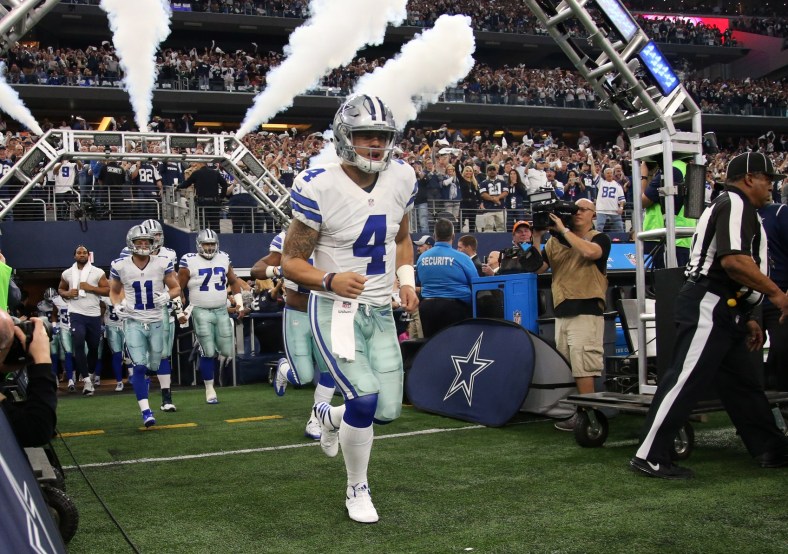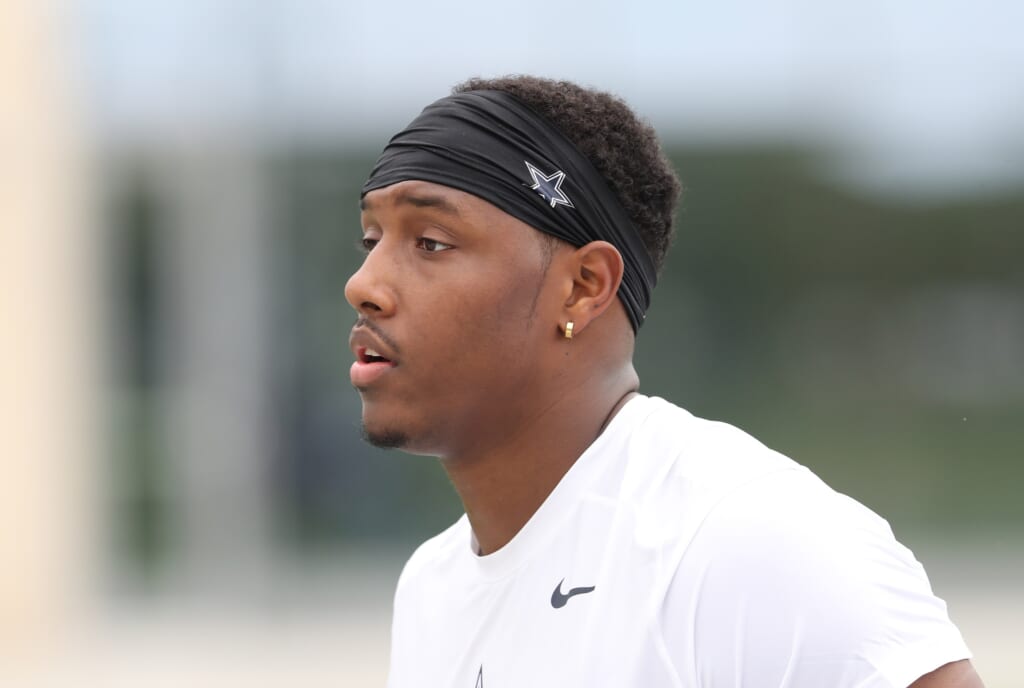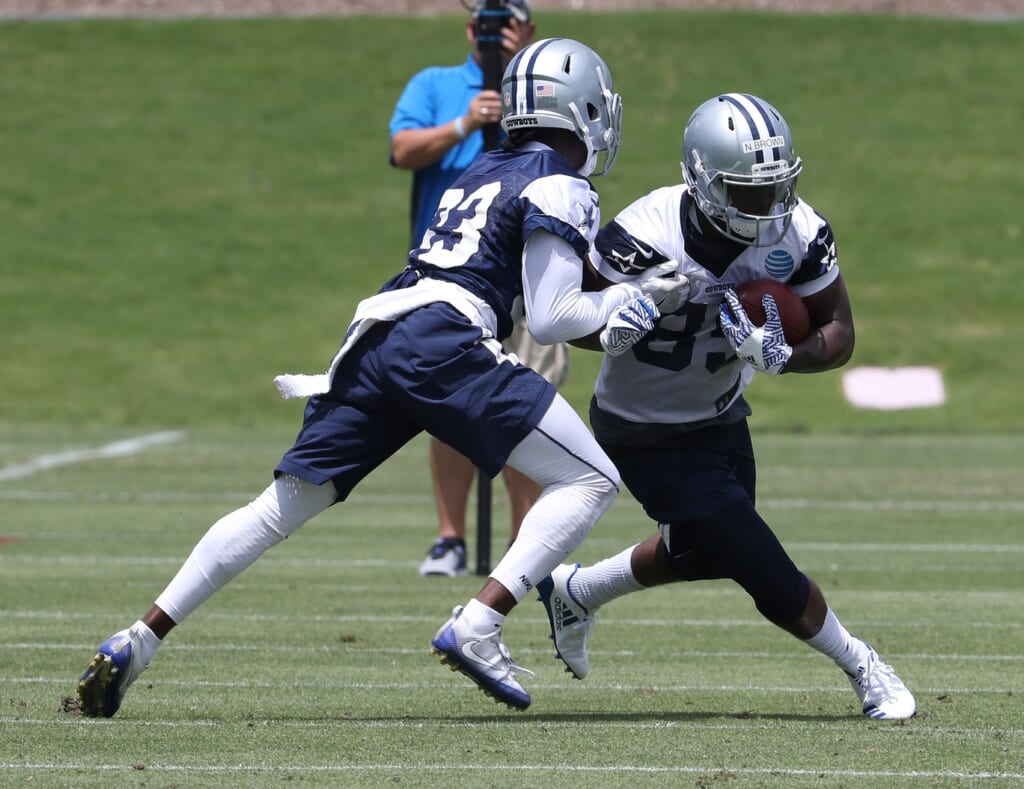
2016 was a dream season for the Dallas Cowboys. They conjured a quarterback of the future out of the blue in Dak Prescott and found a star running back in Ezekiel Elliott. Their offense ran circles around the league, making the Cowboys one of the league’s most fun teams to watch. Along the way they won 13 games and claimed the top seed in the NFC.
The transition from the Tony Romo era to the Prescott era was completely accidental and completely seamless. Because of that, the Cowboys come into the 2017 season with Super Bowl expectations.
Whether more credit should go more to Prescott or his teammates is impossible to say with certainty. But the young quarterback reaped the rewards. He ranked near the top of the league in every statistical measure — third in QBR, fourth in DYAR, third in DVOA, fourth in yards per attempt, third in adjusted net yards per attempt, third in passer rating and so on. He rarely made mistakes, throwing just four interceptions with an interceptable pass every 38.2 attempts, per Cian Fahey’s charting.
He didn’t make a ton of spectacular passes and had an incredible supporting cast, but Prescott proved himself to be the real deal. More than that, he did so in his rookie season. And his supporting cast this year is nearly as good.
 The running game was where Dallas made its bones last season. Ezekiel Elliott was a First-team All-Pro in his rookie season, rushing for a league leading 1,631 yards. He also had 340 DYAR, which led the league, and a 57 percent success rate, which ranked second. The Cowboys also kept him to 322 carries, which doesn’t feel like a small amount, nor should it. Elliott led the league in carries. However, compared to the 392 carries DeMarco Murray received in 2014, which seemed to break him the next year, 322 shows restraint.
The running game was where Dallas made its bones last season. Ezekiel Elliott was a First-team All-Pro in his rookie season, rushing for a league leading 1,631 yards. He also had 340 DYAR, which led the league, and a 57 percent success rate, which ranked second. The Cowboys also kept him to 322 carries, which doesn’t feel like a small amount, nor should it. Elliott led the league in carries. However, compared to the 392 carries DeMarco Murray received in 2014, which seemed to break him the next year, 322 shows restraint.
If a capable backup doesn’t emerge between Ronnie Hillman, Darren McFadden and Alfred Morris, however, Elliott could get another year with a huge workload. The Cowboys should aim to keep him under 300 this season — at age 22, it’s just stupid to risk Elliott’s future.
While all the attention was focused on Prescott and Elliott, the Cowboys’ receiving corps didn’t get nearly enough credit, in part because Dez Bryant had a boilerplate season. Bryant put up a relatively pedestrian 796 yards (which probably would have risen to 1,000 had he played 16 instead of 13 games) along with 50 receptions. If he can stay healthy for all 16 contests this season — he hasn’t the last two — there could be a slew of renaissance stories surrounding him given that Bryant hasn’t received much recognition as one of the league’s premier receivers in recent years. The fact of the matter is, other than a drop in catch rate which can mostly be attributed to playing injured two seasons ago, he’s roughly the same player.
Cole Beasley, however, is not. Beasley quietly had an astounding 2016, finishing in the top five among receivers in both DYAR and DVOA. He had 75 receptions on 98 targets, going for 833 yards and establishing himself as one of the best slot receivers in football. Beasley’s emergence helped make up for the drop-off of tight end Jason Witten. It took a while, but the decline finally started to show in full force last season. Witten was below average among tight ends in both DVOA and DYAR. He had only 673 yards, the lowest mark of his career since 2003. Maybe Witten can still be reliable on third-and-short, but the decline is in full force. Terrance Williams is a very good third option. The advanced stats overstated his impact vastly — Williams was somehow fourth among receivers in DVOA — but a 72 percent catch rate and 13.5 yards per reception is wonderful for a third option.
The only place the Cowboys’ offense may struggle, ironically, is the offensive line — the unit that has consistently been its best feature, including last season. The line ranked fifth in adjusted line yards and third in power success in 2016. But there has been changeover. Right tackle Doug Free retired and left guard Ronald Leary went to Denver. Free was the worst player on the line by far and Leary was a step below the other three. Left tackle Tyron Smith, center Travis Frederick and right guard Zack Martin — all superstars — are still there. So it’s not as if we’re sounding alarm bells here.
Whether or not the Cowboys can replace Free is going to hinge mostly on La’El Collins. Collins went undrafted out of LSU in 2015 because of off-field issues, has absurd physical talent and, when he got a chance to start at left guard in 2015, was terrible. Despite some plays that made highlight reels, Collins simply wasn’t good enough and that was at an easier position. In fairness to him, it’s been two years and he has a ton of talent. It’s perfectly possible that he’s capable of playing right tackle well. If that’s the case, Jonathan Cooper will probably slide in at left guard and things will be fine. If Collins fails, however, he’ll probably move to left guard, be marginally better at his natural position, and leave the Cowboys with Chaz Green at right tackle, which is less than ideal.
The Cowboys contending for a Super Bowl, however, won’t be decided by their offense so much as their defense. Dallas was able to keep its head above water on that end last season, but with a 0.8 percent defensive DVOA, only barely. And it’s tough to make the case that they got better.

On the line, the only big change is drafting Taco Charlton. Charlton impressed on tape enough that we’re willing to put aside unfavorable statistical projections here, though they are worth noting. Most notably, he has an array of moves. Unlike most prospects, who can win with a speed or bull rush, Charlton has ability with both along with rip and spin moves. The spin in particular was responsible for one of his best performances of the year, a drubbing of Wisconsin tackle Ryan Ramczyk, who was also picked in the first round this season. Run defense won’t be his specialty, but Charlton was solid there, showing decent ability to hold his gap and get off blocks when necessary. At 28th overall, there are much worse things Dallas could have done.
However, the rest of the line is still an issue. Maliek Collins had an abysmal 42.7 PFF grade last season and ranked 71st among defensive tackles in run stop rate, per Football Outsiders Almanac. David Irving had an encouraging 2016, but he was suspended four games for using PEDs. The Cowboys will miss him, and even when he gets back, who knows if Irving is the same player? Tyrone Crawford was a decent enough player but not an impact guy. Unless Charlton flies out of the gate, that impact lineman probably isn’t on this team.
At linebacker, Sean Lee is still a star if he stays healthy. Last season, he finished fifth among linebackers in PFF grading at 87.3. However, Lee may be the only reliable player at the position. Anthony Hitchens had an abysmal 34 percent success rate and gave up 11.0 adjusted yards per target, per FOA. Damien Wilson played only 284 snaps last season, but he had a 44-percent run stop rate, per FOA, and there isn’t much depth. Jaylon Smith has a high ceiling, but he’s as much of a question mark as any player in football. Beyond that, things start to get very dicey with Justin Durant injured and little experience further down the depth chart.
The secondary is where the success of this defense will really be decided. Barring injuries at cornerback, Dallas drafting Chidobe Awuzie and Jourdan Lewis indicates that Byron Jones will probably be at safety for the long haul. He did a solid job there last season with a 55 percent success rate that ranked ninth last season, per FOA. Next to him, Jeff Heath is an absolute question mark having never been a full-time starter nor particularly outstanding in a backup role. Xavier Woods, a ball-hawking sixth-round defensive back, could see playing time at strong safety as well.

At corner, the Cowboys hope they drafted their future in Awuzie and Lewis. They may well have. However, in the near term, it’s hard to rely on two rookies. Awuzie looks to be capable in zone, which the Cowboys primarily play, but he will allow separation when Dallas slides into Cover-1. Run defense could be an issue as well. The old adage of “make corners tackle” will go double when he’s on the field. Expect opponents to consistently go towards his side of the field to try and force Awuzie to make a play. Lewis had elite stats in college, ranking sixth in cover snaps per reception, according to PFF, but he can be a bit of a gambler. He and Awuzie look like a solid tandem in the long term, but for this year, it’s tough to say.
Orlando Scandrick hits 30 this season and, despite elite run defense ability for a corner, it’s increasingly tough to trust him in coverage. Scandrick had a 43-percent success rate in coverage last season, which was abysmal, and gave up a pedestrian 7.3 adjusted yards per target, according to FOA. That won’t get better as he gets older. Anthony Brown has youth, but he is still very much developing. In the future, he could play on the outside opposite Awuzie. For now, he has to get better if the Cowboys want their secondary to be reliable.
Dallas is a marginally worse team than last season on paper. Losses on the offensive line and the lack of strong replacements for Barry Church and J.J. Wilcox at safety — Jones moving there full-time notwithstanding — will hurt. But Prescott and Elliott are young and improving. If the defense is in the same slightly above average position it was last season, the Cowboys are running away with the division and in the Super Bowl mix with a future that’s even brighter.
If you would like to learn more about the advanced stats we used, check out FootballOutsiders.com, which is largely free, or ProFootballFocus.com which is not.